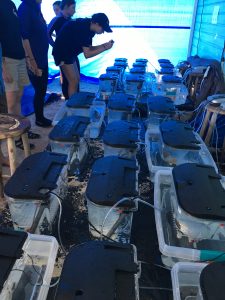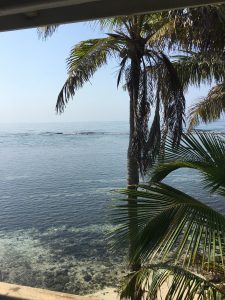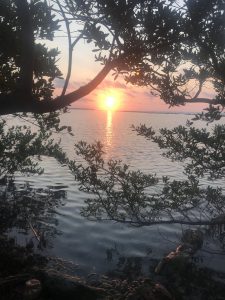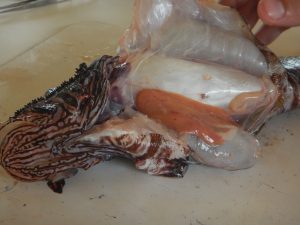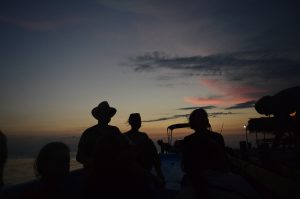Okay reflection here we go:
There are many similarities between the tropical rainforests and the coral reefs. Starting with the most obvious, both ecosystems rely heavily on water. Both ecosystems seem to have alternating states, whether it be the seasonality in the rain forest (wet vs. dry), or the tides in the ocean (high vs. low) that can differ between the hours. The organisms in each ecosystem have various stages of their life cycles in sync with the different cycles that occur in their environment, such as mating during the start of the wet season, etc. This variation in the environments allows for speciation; when one species is inactive, another in a similar niche can thrive, and so forth.
Another similarity, which is something that I did not know about before this trip, is the paradox of both environments being in and of themselves nutrient poor, yet somehow being able to support staggering amounts of biodiversity. In our little experiments in the Chiquibul for example, we were able to identify, morphologically speaking, approximately 60 different species of arthropods that wound up on our various vials, The fact that this number is a ridiculously small fraction of what is actually out there is absolutely mind blowing. Before the trip, I was wondering how to get as many species of my taxa possible on my taxon ID cards. I foolishly thought that I would be alright with approximately 24 species of trees and 24 of herbivorous fish- I mean were going to areas that were only so big, how diverse can the species get? The truth is, I didn’t see anymore than 8 or so of the species on my ID cards, both in the rainforest and on the reef. That isn’t because there simply were 8 or so of each taxon in each ecosystem- its because there were so many species of each taxon and they were so spread out around the ecosystem, somewhat “diffused” along with hundreds of other species that it was hard to identify them based on a very limited knowledge of their physical characteristics and distribution, bot to mention the fact that so many species looked SO similar, especially in regards to the trees, but in fact were different species entirely. While I knew before that there were MANY species in the rainforest, I think it was difficult for me to grasp how many is many until I got a small glimpse of it myself. This was one thing that somewhat did surprise me about the course; no matter how much you think you know, or how positive you can distinguish one species from one that looks strikingly similar other than a minor variation in the veins of their leaves, you will never actually know all that much at all.
I didn’t realize that working underwater would be such a challenge. Of course, this was my first experience with snorkeling, let alone my first time trying to collect data underwater- I’m sure more experienced researchers won’t get salt water into their eyes as often as I did. However, I’m pretty certain that whether you are a novice or a marine biologist with 20+ year experience, goggles will get foggy, calves will cramp up, transect tapes won’t always stay in place and quadrats will sometimes refused to fall flat on the benthos. We were lucky that there were basically no waves and the sea was very calm. I could not imagine doing the same things we did, like measure coral coverage on the benthos, in very windy or rough conditions. Communicating underwater was quite difficult as well. Most of the time, if what I was trying to say didn’t get through to the other person, we both just surfaced so could talk out loud. I imagine in conditions or project that are time constrained, researchers would need to have a detailed communication system in place so that they won’t have to waste precious time trying to ask someone to lend them their camera.
One last thing that I didn’t really think about much until this course was about how much overlap there is between different fields of study, and how humanity is tied to nature, not matter how far away from it we think we are. Biology is ecology and evolution, yes, but it is also philosophy and physics and geology and politics and chemistry and sociology and history and nearly any field you can think of. People shape their environment, but the environment shapes people too. The things that we learned about the Maya civilization, their use of the land (the trees!), their culture, their struggles and their eventual downfall is all ingrained in the biology of the land as well, from the slashed on the bark of the chicle trees, to the changing soil qualities due to slash and burn agriculture. It really made me think about questions concerning geopolitical borders- the Guatemalans can’t harvest Xate but Belizeans can, just because they are on the wrong side on an imaginary line? The Chiquibul – and nature as a whole- doesn’t follow the rules of man.
Belize was hot. More humid in the forest, and a stronger sun on the island. However, in the forest, the nights were cooler and in Glovers’, we had that occasional ocean breeze.
Complaints? I’ve been told I have had them. As I can’t really think of anything that’s been bothering me up until right now, I think all of my complaints were in the moment, mostly. My various bites are still itchy as hell, but I’m sure I won’t even be remembering them in a few weeks. If I had to pick my least favorite part of the course, I would probably be when my sunscreen keep getting into my eyes while snorkeling and I couldn’t keep them open for hours afterwards- that is until we realized that that was the cause of my temporary blindness and I stopped using sunscreen on my forehead.
It is hard to choose one favorite part of the course, but I can say that all my favorite parts were shared with the people who I have personally learned so much from throughout this course, whether it was about the various lectures we’ve had, or otherwise. We all talked about how much of a surprise it was when we looked over the camera trap pictures and saw the jaguars, or how cool it was to climb around inside the ATM cave, or see scarlet macaws in the wild. The experiences we had during this trip were one of a kind and I will treasure them forever, but I think that my favorite part overall was being able to meet such amazing human beings with the same passion for science and learning and the environment and people as I have, and the opportunity that I had to experience this truly eye opening trip with them.
I think I somewhat came into this course thinking: okay this is it, after May 29th I will be able to decide whether or not I want to do field work in my career as a biology. I expected to have the answer to the question I’ve been asking myself for the past few months, now that graduate school applications are looming overhead. But now I realize that the answer is not that simple to be answered after a two week experience, no matter how amazing it was. Will I know pursue a career as a tropical field biologist, or even field work in general? Honestly, it’s too soon to tell. I’ll probably have to let my sand fly bites heal before I start thinking about that. What I can say now is that no matter what specific field of study I choose to pursue in my career in EEB, I can always look back at this trip to remind myself of why I do what I do- because I love science and I love what science can do for people, and what science has the potential to do for all of the earth and its creatures.


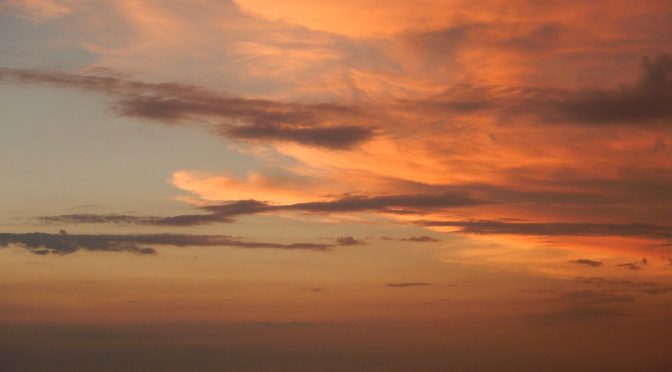
 The sky over our last night in Belize. Once again, this photo is NOT color corrected!
The sky over our last night in Belize. Once again, this photo is NOT color corrected!